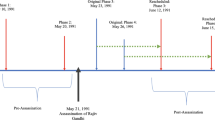Abstract
The aggregate empirical side of computational social choice has received relatively little attention. This paper provides a progress report on our on-going research project on statistical characterizations of the outcomes of vote-casting processes. We describe a statistical model that is capable of generating voting situations for three-candidate elections that have a distribution very similar to that of observed voting situations. We show that our simulated voting situations can provide interesting insights into the question of which voting rule is most likely to identify the best candidate.
Similar content being viewed by others
References
Banzhaf, J.F.: One man, 3,312 votes: a mathematical analysis of the Electoral College. Villanova Law Rev. 13, 304–346 (1968)
Borda, J.C.: Mémoire sur les élections au scrutin (1784). Translated in: de Grazia, A. Mathematical derivation of an election system. Isis 44, 42–51 (1953)
Brams, S., Fishburn, P.: A nail-biting election. Soc. Choice Welf. 18, 409–414 (2001)
Cervone, D., Gehrlein, W.V., Zwicker, W.: Which scoring rule maximizes Condorcet efficiency under IAC. Theor. Decis. 58, 145–185 (2005)
Chamberlin, J.R., Featherston, F.: Selecting a voting system. J. Polit. 48, 347–369 (1986)
Condorcet, M.J.A.N.: Marquis de: Essai sur l’application de l’analyse à la probabilité des décisions rendues à la pluralité des voix. Paris (1785)
Conitzer, V., Sandholm, T.: Common voting rules as maximum likelihood estimators. In: Proceedings of the 21st Annual Conference on Uncertainty in Artificial Intelligence (UAI-05), pp. 145–152 (2005)
Garman, M.B., Kamien, M.I.: The paradox of voting: probability calculations. Behav. Sci. 13, 306–316 (1968)
Gehrlein, W.V.: Condorcet winners in dual cultures. Presented at the National Meeting of the Public Choice Society. New Orleans, LA (1978)
Gehrlein, W.V.: Condorcet’s paradox and the likelihood of its occurrence: different perspectives on balanced preferences. Theor. Decis. 52, 171–199 (2002)
Gehrlein, W.V.: Consistency in measures of social homogeneity: a connection with proximity to single-peaked preferences. Qual. Quant. 38, 147–171 (2004)
Gehrlein, W.V.: Condorcet’s Paradox. Springer, Berlin Heidelberg New York (2006)
Gehrlein, W.V., Fishburn, P.C.: Condorcet’s paradox and anonymous preference profiles. Public Choice 26, 1–18 (1976)
Gehrlein, W.V., Lepelley, D.: Voting Paradoxes and Group Coherence: The Condorcet Efficiency of Voting Rules. Springer, Berlin Heidelberg New York (2010)
Gehrlein, W.V., Plassmann, F.: An empirical evaluation of the Borda compromise. Mimeo (2013)
Gelman, A., Katz, J.N., Tuerlinckx, F.: The mathematics and statistics of voting power. Stat. Sci. 17(4), 420–435 (2002)
Good, I.J., Meyer, L.: Estimating the efficacy of a vote. Behav. Sci. 20, 25–33 (1975)
Good, I.J., Tideman, T.N.: From individual to collective ordering through multi-dimensional attribute space. Proc. R. Soc. Lond. Ser A 347, 371–385 (1976)
Henry, M., Mourifié, I.: Euclidean revealed preferences: testing the spatial voting model. J. Appl. Econometrics (2011). doi:10.1002/jae.1276
Kuga, K., Nagatani, H.: Voter antagonism and the paradox of voting. Econometrica 42, 1045–1067 (1974)
Laslier, J.F, van der Straeten, K.: A live experiment on approval voting. Exp. Econ. 11, 97–105 (2008)
Mattei, N.: Empirical evaluation of voting rules with strictly ordered preference data. In: Brafman, R., Roberts, F., Tsoukiàs, A. (eds.) Algorithmic Decision Theory, pp. 165–177. Springer, Berlin Heidelberg New York (2011). doi:10.1007/978-3-642-24873-3_13
Merrill, S.: A comparison of efficiency of multicandidate electoral systems. Am. J. Pol. Sci. 28, 23–48 (1984)
Plassmann, F., Tideman, T.N.: How to predict the frequency of voting events in actual elections? (mimeo)
Plassmann, F., Tideman T.N.: How frequently do different voting rules encounter voting paradoxes in three-candidate elections? Forthcoming Soc. Choice Welf. (2013) doi:10.1007/s00355-013-0720-8
Regenwetter, M., Grofman, B., Marley, A.A.J., Tsetlin, I.: Behavioral Social Choice. Cambridge University Press, Cambridge, UK (2006)
Regenwetter, M., Grofman, B., Popova, A., Messner, W., Davis-Stober, C., Cavagnaro, D.: Behavioural social choice: a status report. Phil. Trans. Royal Soc. B: Biol. Sci. 364, 833–843 (2009)
Saari, D.G.: Analyzing a nail-biting election. Soc. Choice Welf. 18, 415–430 (2001)
Tideman, T.N.: Collective Decisions and Voting. Ashgate, Burlington (2006)
Tideman, T.N., Plassmann, F.: Modeling the outcomes of vote-casting in actual elections. In: Felsenthal, D.S., Machover, M. (eds.) Electoral Systems: Paradoxes, Assumptions, and Procedures. Springer, Berlin Heidelberg New York (2012)
Tideman, T.N., Plassmann, F.: Which voting rule is most likely to choose the “best” candidate? Forthcoming Public Choice (2013)
Young, H.P.: Optimal ranking and choice from pairwise comparisons. In: Grofman, B., Owen, G. (eds.) Information Pooling and Group Decision Making. JAI Press, Greewich (1986)
Young, H.P.: Condorcet’s theory of voting. Am. Pol. Sci. Rev. 82, 1231–1244 (1988)
Author information
Authors and Affiliations
Corresponding author
Rights and permissions
About this article
Cite this article
Tideman, T.N., Plassmann, F. Developing the aggregate empirical side of computational social choice. Ann Math Artif Intell 68, 31–64 (2013). https://doi.org/10.1007/s10472-013-9360-z
Published:
Issue Date:
DOI: https://doi.org/10.1007/s10472-013-9360-z




